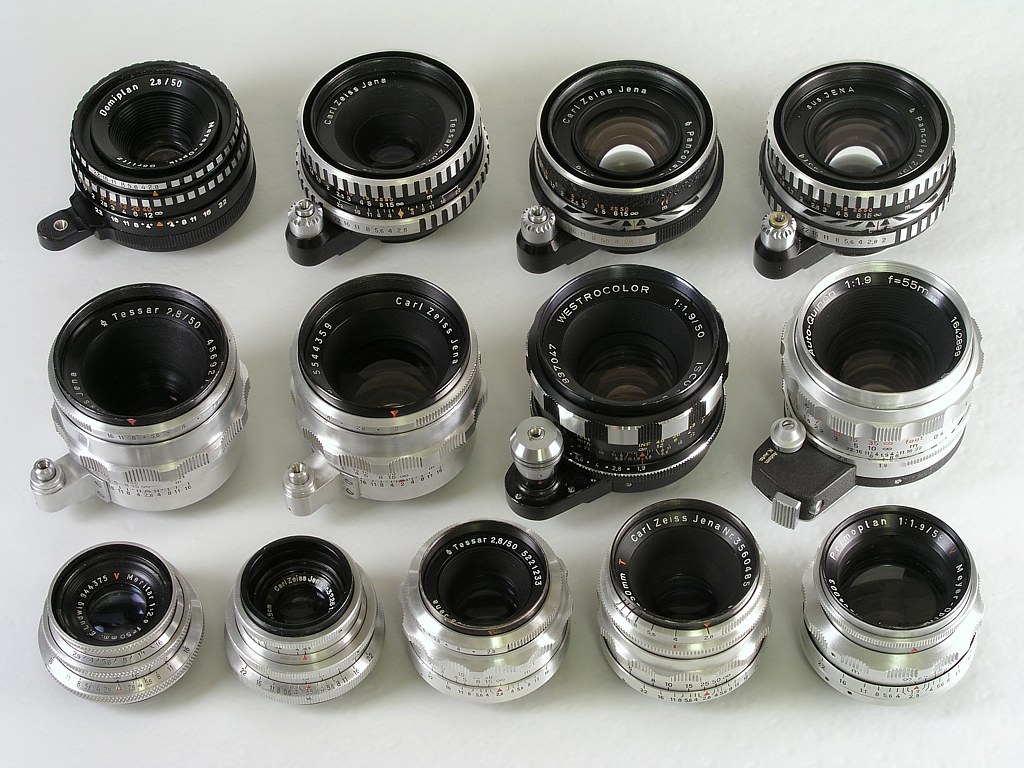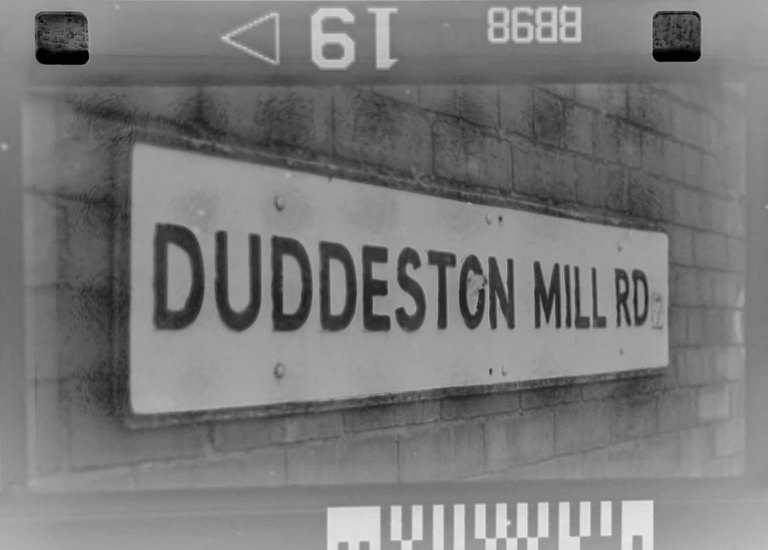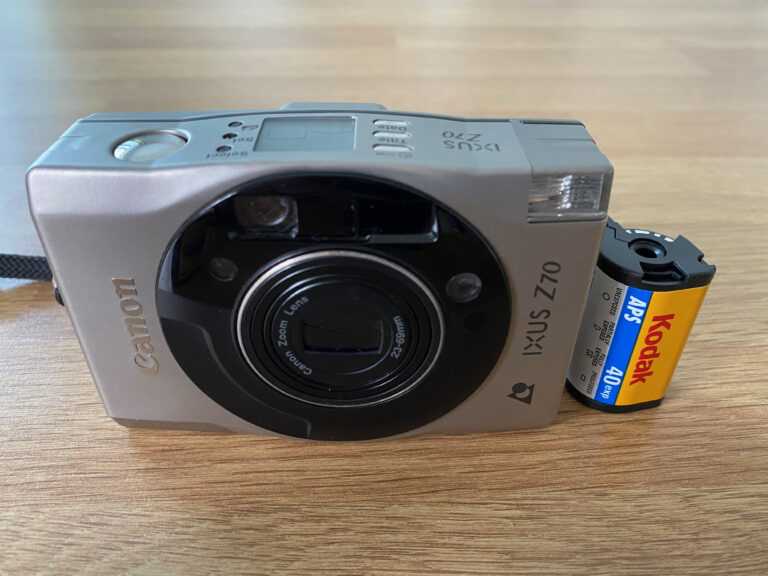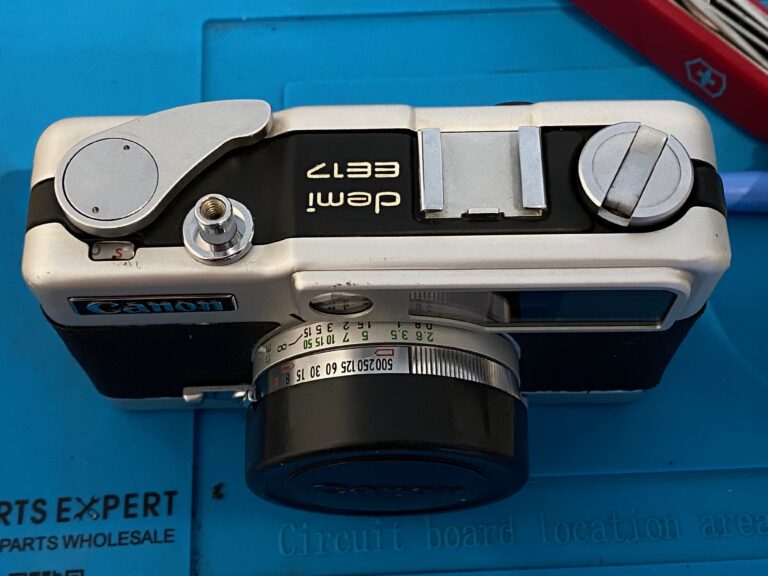According to a leaflet that came with my Exa 1a, this camera is “the rapid-action all-purpose camera that’s within everyone’s means!” One part of that statement is true today, this is an Ihagee camera that is cheap enough that anyone could purchase one. Mine came boxed with the original receipts for all of £23, whereas “proper” Exacta’s and other Ihagee cameras that are in good working order sell for well over £100.
The Exa 1a is a quirky, cut down budget slr with a waist level viewfinder. You get access to a range of interchangeable lenses if you can afford to buy them and an entirely mechanical body capable of shutter speeds up to 1/175th of a second. There are no luxuries such as metering and even aperture control is your problem, this is almost as manual as it gets.
Exacta cameras are very collectable and highly regarded by their owners, but does this “baby Exacta” give the budget conscious photographer a cheap way in to the world of Ihagee cameras or is it simply a budget step too far? I bought one to find out the answer. Actually, that’s a lie, I bought one because it had a waist level finder and I fancied using one on an SLR…
In this post:
Who are Ihagee?

Ihagee was founded in 1912 and is the phonetic abbreviation of “Industrie und Handelsgesellschaft” – a catchy name for a business if ever there was one. This literally translates to “Industrial and Trading Company.” Around 1936, Ihagee introduced the Exacta, the worlds first 35mm interchangeable single lens reflex (SLR) camera and thoroughly cemented their rightful place in photographic history. For quite some time the Exacta was a very desirable, expensive camera and single handedly introduced the idea of the “system” camera where you buy one body and then build up a collection of lenses and other accessories as necessary.
With a launch date of 1936, it’s not surprising that the war quickly came along and disrupted Ihagee significantly. The original owner Johan Steenbergen left Dresden in 1942 and the factory was destroyed during a bombing raid. After the war, the company passed into Soviet control and they quickly resumed production of Exacta cameras with both old and new parts. In 1951, the company was taken over by Pentacon and it is during their ownership that the cheaper Exa variants were released to fill a gap in the lower end of the market.
By the time Ihagee had got back on their feet, however, Japanese manufacturers in particular had begun to master the design of the SLR and were producing cheaper, better made and more capable cameras. By the time Ihagee responded with updated models it was too late and by 1966 the company was on a downward slope with new models being poorly received. Ihagee eventually closed ten years later in 1976.
For a company that invented the modern form of “proper” 35mm photography, their demise is both depressing and fascinating in equal measure.
My Exa 1a

The Exa range of cameras were intended to be entry level, easy to use baby brothers of the more fully featured Exacta range. They shared similar design language with their wide, angular bodies and were compatible with the Exacta bayonet mount lens range and interchangeable viewfinders. This was largely a good idea, customers tend to react favourably when they can access an established line of tried and tested lenses with the potential to upgrade their body to a better model at a later date. The modular construction was a distinct advantage as customers could change viewfinders depending on their taste or requirements – this kind of modularity was found on many top tier professional SLR’s in the 60’s and 70’s such as the Canon F1 and the Nikon F1 and F2.

The Exa 1a was launched in 1964 as a small upgrade over the existing Exa 1 from 1962. It’s an odd camera to say the least. The mirror assembly is part of the shutter so when you take a picture, the mirror moves up to block out the viewfinder and the film is exposed. A second shutter is then brought down over the film to end the exposure whilst the mirror stays up and will not return until the film is wound on. The film winder does three things – winds the film, primes the shutter for the next exposure and brings down the mirror for the next shot.
The shutter speeds are mechanically controlled and you can have any shutter speed you like so longs as you like bulb, 1/30, 1/60, 1/125 and rather oddly 1/175. That’s your lot, so don’t imagine you’re going to be freezing action shots with the Exa 1a and nor are you going to use long lenses without a sturdy tripod. There are zero other features on the camera other than a rather nice pop up viewfinder with built in magnifier, the kind you find on TLR cameras.

My lens is the most bottom of the range lens they ever sold – a 50mm F2.9 Meritar by E. Ludwig. This was the cheapest lens available and it shows – slightly disappointingly I didn’t get one of the far better Zeiss Tessar lenses. The Meritar lenses have completely manual aperture which must be set before tripping the shutter and after setting focus, whereas Tessar lenses came with a built in shutter button that served not only to trigger the shutter on the camera but to close down the aperture as well. This is much more desirable and preferable than wasting frames when you realise you forgot to manually stop the lens down.
Shooting a roll of film

I decided to use a roll of colour film for once and shot the Exa 1a with a roll of Kodak Gold 200. That’s an expensive decision to make these days as it’s around £9 for the film and another £10 to develop it, so £20 for 36 images isn’t a decision to take lightly.
I’m going to be up front – I regret my choice. The Exa may not be to blame for the poor results, but the lens certainly is. The quality of images from the Meritar is woeful. I did wonder whether this might just be a case of user error, but no, the Meritar is slated pretty much everywhere I could find any information about it. A couple of my shots were accidentally taken wide open and I’d expect some softness on a cheap lens at maximum aperture, but most other shots were taken around F11-F16 and these are equally miserable.
Some of the pictures are so bad that at first I thought the film had somehow become reticulated. This doesn’t appear to be the case as far as I can tell, however there are artefacts and oddness all through the roll including what looks like some kind of odd light leak at the top of frames when taking pictures with particularly bright areas of sky – a sort of odd crescent of light appears at the top of the frame.

The faults don’t stop there, though. My Exa 1a hasn’t had a hard life at all, it is in really rather mint condition for something so old. Unfortunately, every now and again, the film winder will fail to function properly. It pulls the film across and primes the shutter but doesn’t bring the mirror down which results in a lost frame as you have to perform a second wind and then it’ll latch, returning the mirror correctly. On my roll of 36 exposures, I lost three frames because of a refusal to return the mirror by the winding mechanism.
You’re probably getting the impression that I didn’t enjoy using the Exa 1a very much and in some ways you’d be right. I think the camera is more than capable of taking a decent image with a lens upgrade, so I can forgive that. I also believe that the film winding/mirror return problem could well be a symptom of old age and a lack of servicing – so I’ll forgive that also. What I can’t get over, though, is the viewfinder and that is the one thing I was really looking forward to using with this camera.
I last used a waist level finder with the Yashica LM TLR I reviewed a year or two back. That camera is a beautiful piece of engineering and, as with all TLR’s it has a waist level finder out of necessity. The thing is, TLR’s take square format images and this makes one significant difference – you are never going to have to try and use it to take a picture in portrait orientation. Imagine lying a TLR on its side whilst framing and image and you’ll understand where I’m going. The second advantage a TLR has is that the viewfinder is comparatively massive, but even then they come with large magnifiers so you can get the focus spot on.

The waist level finder on the Exa 1a is pretty horrible. It isn’t that bright to begin with and the magnifier isn’t enough to enable you to get the focus absolutely bang on. Despite this, you can compensate with smaller apertures and that should give you a huge depth of field to forgive any small lack of accuracy in focus. Only it doesn’t. There are some images where I can’t tell if it is simply the lens being soft as spreadable cheese or I completely missed focus. No idea. Would this be better with a higher quality lens? Probably, my lens is only capable of F2.9 which isn’t exactly dark but I’m sure some improvement would be seen with one of the better F1.9 lenses.
Consequently, because it is a 35mm format camera, you absolutely would think it reasonable to try out a portrait shot. My advice is don’t. It is hard enough to adjust yourself mentally to everything being in reverse with a waist level finder, putting it on its side and being in reverse is a whole new world of confusion. Taking portrait shots without a tripod is simply hilarious as you wobble around, disoriented, trying to frame something up but every movement you make doesn’t make sense let alone move you closer to the picture you imagined. I’m willing to post my Exa to anyone who’d like to have a go at falling over in public for themselves…
The range of shutter speeds is extremely limiting, even with slower films. This was probably much less of an issue in the 1950’s-60’s as ISO 100 film would’ve still been considered a “fast” film back then and ISO’s of 25 and 50 were more than common. With modern film choices being more limited, especially in the colour market, you’ll miss having the option to shoot faster shutter speeds than 1/175. The chances for camera shake are also fairly high, especially if you do resort to 1/30 or 1/60.
What can we say that is positive about the Exa 1a? Well, the camera feels quite nice to hold and build quality is generally quite sturdy, although the viewfinder mechanism does feel fragile. The winding mechanism is lovely and has a great sound, something like winding a small mechanical clock very quickly. It makes a fantastic “ZZZIIP” noise as you set the camera up for the next shot. The shutter mechanism is equally satisfying, probably down to the fact it’s a hefty lump and makes a dampened thud as it blacks out the viewfinder.
Conclusions

I wanted to love the Exa 1a, I really did. It came in such lovely condition, complete with all the provenance you could want with an old camera. I normally love the slower, more methodical nature of shooting a more manual camera than I usually use, but after the Exa started to show its quirks and limitations, I just found myself growing disenchanted with it.
How much of this is down to expectation versus reality? I’m not sure. I had a great time recently with the absolutely bottom of the range, cheap as chips Cosmic 35 – a camera so cheap that I’m surprised they didn’t used to fall out of breakfast cereal packets. Was that because I had zero expectations of it? A camera like that is expected to be useless, so anything else is a bonus and therefore expectations are set accordingly. With the Exa, I expected a more upmarket experience and didn’t really get it.
Ultimately, I think Ihagee compromised far too much with their attempt at a low end, budget model. They knew how to make fantastic cameras and definitely knew how to innovate, but the Exa 1a feels a bit too much like a company trying to not eat their own lunch. Probably due to fears around sales, they crippled the available shutter speeds and compromised on the SLR experience with the weird shutter/mirror mechanism that doesn’t give you a great viewfinder experience at all. This, combined with the worlds worst lens culminated in some of the most disappointing images I’ve taken for a long time.

Do I want to try out a proper Exacta? Yes. That would probably restore my faith in Ihagee cameras, but I’m in no hurry to spend north of £100 on one of these, not when for the same money you could have a Canon A1, EOS 1, Yashica LM… Sadly, I can’t see that an Exacta is going to be a better experience than any of those and that means that for the foreseeable future, it’s not going to be on the radar to pick up. That’s a shame, really.
Share this post:




